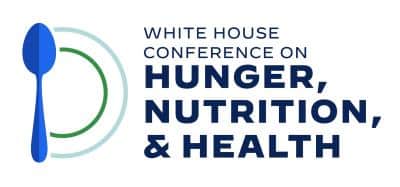Report from The White House Conference on Hunger, Nutrition and Health
“In America, no child should go to bed hungry. No parent should die of disease that can be prevented,” President Joe Biden stated as he opened the September 28th White House Conference on Hunger, Nutrition, and Health. The historic event — 50 years in the making — brought together over 500 food, health and nutrition professionals and advocates in Washington D.C., while thousands, like me, watched virtually.
The issues of food insecurity and prevalence of chronic disease in the U.S. are not new problems. Federal, state, and local programs have addressed these issues over the past 50 years with some success. But we must be realistic and agree some solutions have been “money down the drain” as the problems remain. During the COVID pandemic, the light shined brighter on our shortcomings. The question remains, can we move forward together and address the hunger, nutrition and health issues for all? Public-private partnerships, increased focus on federal food programs, and the need to fund prevention care all were highlighted during the Conference. If we are to accomplish the end game to “end hunger and increase healthy eating and physical activity by 2030, it will take all of us — regardless of where we live or work! It’s time!
The Pillars of Discussion
The White House Conference released the National Strategy Report prior to the Conference, highlighting the key pillars of priority. The report included the Academy of Nutrition and Dietetics recommendations to strengthen the national commitment to nutrition research, diversify the nutrition and dietetics workforce, and increase access to nutrition services. Current Academy president Ellen R. Shanley, RDN, commented, “the report prioritizes nutrition security, which is a crucial step in addressing health equity and achieving the Academy’s mission to accelerate improvements in global health and well-being through food and nutrition.”1
The five pillars’ recommendations include:2
1. Improve food access and affordability: Seek ways to make it easier for everyone —regardless of community to have access to affordable food. For example, increase access to free and nourishing school meals; provide Summer Electronic Benefits Transfer (EBT) benefits to more children; and expand Supplemental Nutrition Assistance Program (SNAP) eligibility to more underserved populations
2. Integrate nutrition and health: Make nutrition and food security a center point in overall health for all. For example, seek Congressional approval for a pilot program for medically tailored meals in Medicare; include Medicaid coverage of nutrition education; and expand Medicaid and Medicare recipients’ access to nutrition and obesity counseling. (Preventive health can pay!)
3. Empower all consumers to make and have access to healthy choices: Create environments — from schools to workplace — that promote healthy food choices for all. Proposals included: developing a front-of-package labeling scheme for food packages; updating the nutrition criteria for the “healthy” claim on food packages; expanding incentives for fruits and vegetables in SNAP; and working on sodium reduction and added sugar consumption in the food supply to reduce added sugar consumption.
4. Support physical activity for all: Make it easier for people to be more physically active. Strategies include expanding the U.S. Health and Human Services CDC State Physical Activity and Nutrition Program to all states and invest in efforts to connect people to parks and other outdoor spaces.
5. Enhance nutrition and food security research: Expand nutrition research and data methods to inform policies around nutrition and food security policy, especially those issues of equity, access and disparity.
Conversations Behind the Recommendations
The White House National Strategy was not developed in a vacuum or without input. During the summer, entities from community-based organizations to state and national healthcare and agriculture groups had the opportunity to provide input on how to address the five defined areas. As mentioned in an earlier blog, I had the opportunity to participate in such an event hosted by Bayer. The ideas were many, but consensus was clear. To solve the issue, the root causes of hunger must be identified. The White House National Stratify Report and Conference reflects many of the recommendations made during the virtual dialogue, especially the importance of private and public partnership and coordination. Public-private partnerships were deemed core to address food access, and grocery stores were identified as a key ingredient. During the White House conference, it was announced that private companies have committed over $8 billion in investments to help reach the White House goals. Commitments by Kroger, Tyson and the retail industry organization FMI are just a few among many companies.3
Be At the Table

Burke County, GA, school feeding program includes neighborhood deliveries
The goals are lofty, and the course is bumpy. Some will say the recommendations will never be reality … and it will take time. But if we reflect on the first and only White House Conference on Food, Nutrition, and Health in 1969, there is promise. Outcomes didn’t happen overnight but the creation of programs like the Special Supplemental Nutrition Program for Women, Infants, and Children (WIC), school lunch and food labeling changes started there.
If we are serious about the end game to “end hunger and increase healthy eating and physical activity by 2030,” we need to be involved. Whether we participated at the September 28th Conference (or didn’t know it occurred), each of us, as citizens, have a responsibility to stop and look around us. It’s time to recognize no one should go to bed hungry. It’s time to end hunger.
References:
1. “Recommendations from Academy of Nutrition and Dietetics Included in Report for White House Conference on Hunger, Nutrition and Health,” Academy of Nutrition and Dietetics, September 28, 2022.
2. EXECUTIVE SUMMARY: Biden-Harris Administration National Strategy on Hunger, Nutrition, and Health, The White House, September 27, 2022.
3. “Key takeaways from Biden’s conference on hunger and nutrition in America,” Ximena Bustillo, National Public Radio, September 28, 2022.

